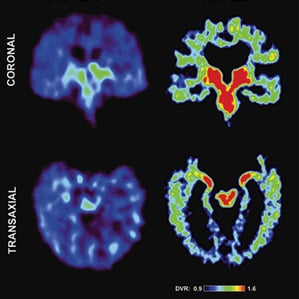Until now, chronic traumatic encephalopathy, caused by repetive head injury, could only be identified after a victim died. CTE is linked to depression, dementia, and memory loss.
A new imaging method, developed by Pittsburgh Steelers physician Julian Bailes and UCLA researchers, can for the first time spot signs of the condition in the living brain. It could help players avoid the degenerative condition by limiting their exposure, and it may help scientists develop better protective gear and treatments.
The technology is based on a positron emission tomography scans. UCLA researchers developed a radioactive compound that can be injected intravenously. The compound circulates through the bloodstream and into the brain, where it gloms onto tau proteins, which can then be measured in a PET scanner. The test takes about an hour.
The radioactive compound also sticks to amyloid proteins. Aggregations of both amyloid and tau are considered culprits in Alzheimer’s disease, whereas tau is the main indicator for CTE. Bailes and colleagues say the regions of the brain that are highlighted in PET scans of patients with Alzheimer’s differ from the scans of patients with CTE.
In related research, Israeli company ElMindA is developing non-invasive BNA (brain network activation) technology. Patients sit at a computer for 15 to 30 minutes, performing a specific task many times while the device maps network activation points in the brain. The repetition allows the device to sift out brain activity unrelated to the task. The result is a three-dimensional image of nerve cell connectivity and synchronization that is highly sensitive, specific and reproducible. The tool is sensitive enough to show subtle differences in the severity of the condition from one day to another, according to the company. They claim that it can also optimize drug dosing by monitoring the changes in brain network activities as the drug takes effect.
 http://www.technologyreview.com/news/522126/identifying-signs-of-chronic-brain-injury-in-living-football-players/
http://www.technologyreview.com/news/522126/identifying-signs-of-chronic-brain-injury-in-living-football-players/
Leave a Reply